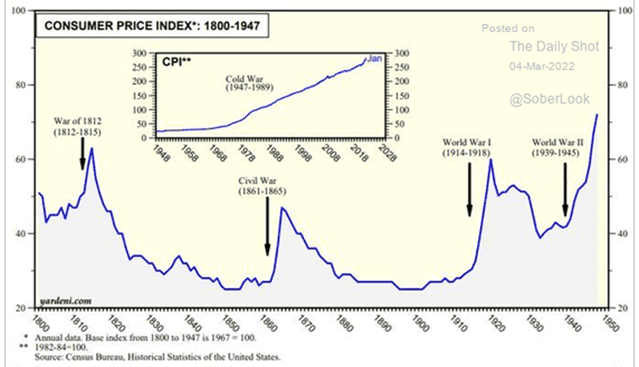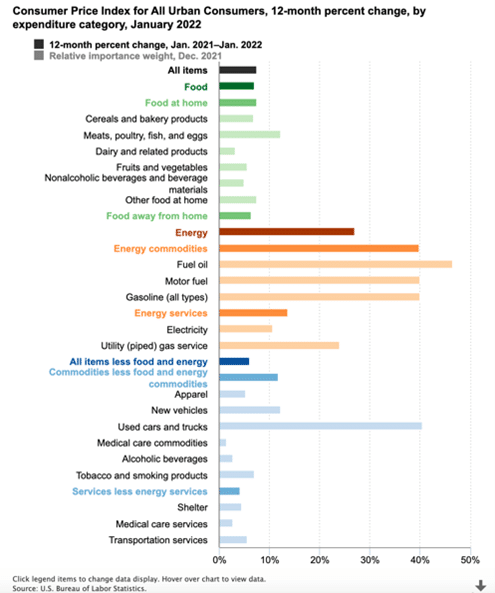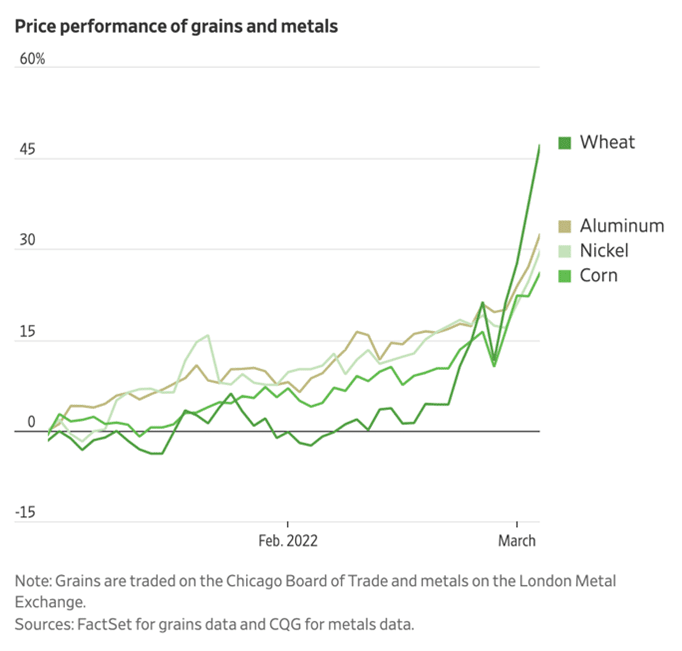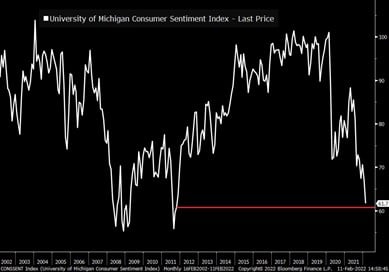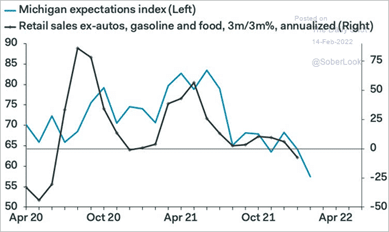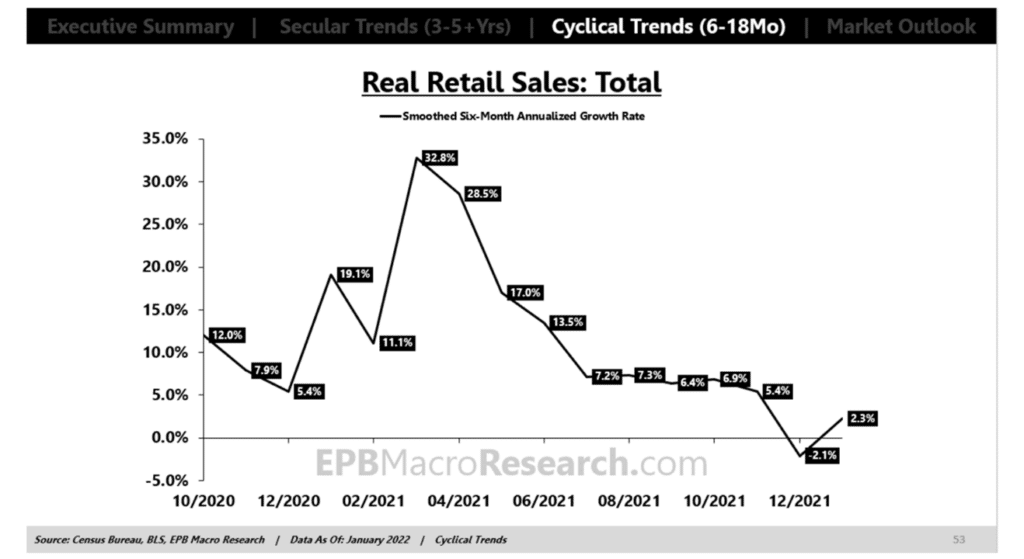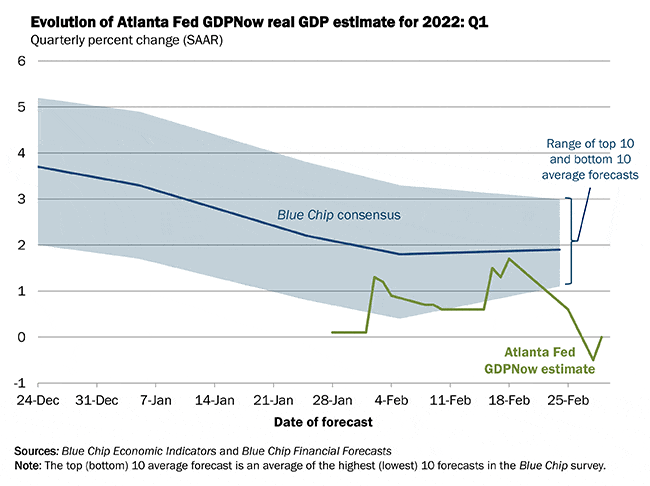Written by: Patrick Hill | The Future Economy
(The Ukraine War) “means a bigger inflation shock, a smaller rates shock, and a bigger recession shock.” -Bank of America Corp. chief strategist Michael Hartnett, 3-4-22
The war triggers a huge surge in oil prices, consumer sentiment is already falling, and the Fed is likely to raise rates slowly because of the war. We examine how: economic sanctions can cause inflation during wartime, consumer sentiment declining, real retail sales under pressure, GDP is weakening, and a unique oil price ratio to 10 – 2-year bond spread indicates a coming recession.
Severe Economic Sanctions Against Russia Enacted
After weeks of planning, as the Russian forces massed on the Ukraine border, it became evident to Western leaders that they must act. During the first few days of the war, the European Union and the U.S. set in motion economic sanctions, including freezing significant oligarch assets in western banks, including Vladimir Putin’s assets, freezing four important Russian bank assets in the west, and cutting off Russian access to the inter-banking SWIFT system. On March 8th, the U.S. placed an embargo on all Russian oil and gas imports. Plus, Russian planes are prohibited from landing in western airports.
U.S. oil businesses have also acted with Chevron, BP, and ExxonMobil, ending their partnerships with their Russian partner companies. Apple and Microsoft have announced the freezing of all operations in Russia. McDonald’s, Starbucks, PepsiCo, and Coca-Cola have suspended product sales and closed thousands of stores. Visa, Mastercard, and American Express have announced suspending transactions in and out of Russia, thus freezing a channel for Russians to move money out of the country. The ruble has crashed to the lowest value versus the dollar in modern times, and the Russian stock exchange is closed. Next, we examine how major wars cause inflation to surge.
Wars Often Trigger Inflation
Major wars throughout history have caused massive dislocations, recessions, and depressions. These massive infrastructure losses of goods, services, food, water, and fuels trigger scarcity and result in inflation spikes. The following chart, courtesy of The Daily Shot, shows from the War of 1812 through WW II that prices shot up after each war. The Vietnam War CPI increased from 1.4% in 1965 to 4.3% in 1971 based on a La Salle University analysis of the President’s Economic Report in 1982.
Sources: Census Bureau, The Daily Shot – 3/4/22
Let’s look at how the allies’ sanctions may impact Western economies and Russia.
Russia is a Major Exporter of Key Commodities Triggering Inflation Surge
Russia is the third-largest oil producer globally and provides 40% of Europe’s natural gas. The country is the world’s largest exporter of wheat and a significant exporter of fertilizer, gold, silver, palladium, and other rare earth metals. The shortages already in place from the pandemic set world markets for most commodities at 10-year highs. Commodities are now set to hit all-time records. The U.S. has announced an embargo on Russian oil, which JP Morgan analysts forecast would jump the price of Brent crude to $150 a barrel for Brent crude quickly. The all-time high for Brent crude was $147.50 in 2008.
Commodity prices are surging across global markets as traders seek out new supplies in a cascade of disruptions. There are over 200 ships stuck at Ukrainian ports, and maritime historians report that more vessels are stranded globally than ever since WWII. The Bloomberg Commodity Index for last week jumped by 12.5%, a high not seen since the 1960s. Next, we look at the U.S. inflation picture. Before the war, inflation was already high in the U.S. The loss of significant commodity imports added to an already high inflation rate will shock the economy.
Inflation Already at Ten Year High Soars
The U.S. is already experiencing a ten-year inflation high, with the CPI at 7.5% for January and energy is one of the key drivers of inflation. The following chart from the U.S. Bureau of Labor Statistics shows how energy (orange) costs, mainly oil drove the CPI increase. It seems that shelter costs are underreported in this chart indicated at 7%. Yet, the Case-Shiller Housing Price Index has jumped 19% year over year, and rents have jumped 12% during a similar time frame.
Source: Bureau of Labor Statistics – 3/4/22
Recently, commodity prices have soared in the U.S. after the February 24th attacks started. The following chart from the Chicago Board of Trade shows how metals and grains have surged in the past week.
Sources: The Chicago Board of Trade, Factset, The Wall Street Journal – 3/4/22
High inflation continues to hammer consumer sentiment.
Consumer Sentiment Decline Driving Retail Sales Down
Before the Russia – Ukraine War, consumers were already concerned about increasing food, shelter, and car prices as consumer sentiment dropped to a ten-year low. Now, the surge in inflation has been driving sentiment down further. A Bloomberg Intelligence study shows that a one-cent change in gas prices influences $1.1B in consumer fuel spending. The following chart from the University of Michigan shows how far consumer sentiment for February has dipped recently to 61.7.
Sources: University of Michigan, Bloomberg – 2/11/22
Consumer sentiment can indicate the direction of retail sales, a significant component of GDP. The following chart, courtesy of The Daily Shot, shows how retail sales track consumer sentiment over three-month periods. The sentiment (blue line) has recently fallen below zero, adding to a retail sales decline.
Source: The Daily Shot – 2/14/22
Retail sales have gone up on a nominal basis, but actual spending has dropped when retail sales are adjusted for inflation. The following analysis by EPB Macro Research uses a 6-month smoothed growth rate of retail sales. The report shows how real retail sales have fallen below zero and sit on the zero line.
Sources: Census Bureau, Bureau of Labor Statistics, EPB Macro Research – 1/31/22
Retail sales include final goods, both durable and non-durable, and consumer services. Further, consider, consumer spending is about 70% of GDP. Therefore, retail sales are a good indicator of GDP direction. Forecasts are indicating a weakening GDP for the first quarter of 2022.
GDP 1st Quarter 2022 Forecast Approaches Zero
The Atlanta Federal Reserve GDPNow estimate shows GDP about zero for the 1st quarter of 2022. Its GDPNow model is an estimate based on a computer model with inputs from various reports throughout the month, including Wholesale Trade, Monthly Retail Report, Personal Income and Outlays, Manufacturing ISM Report, Durable Goods Report, Residential Construction, and several others. The report updates appear about 6 or 7 times a month. The report data was before the Russia – Ukraine War.
Source: Atlanta Federal Reserve – 3/1/22
Based on the shock to the U.S. and the world economy from the war, we expect many of the GDPNow model’s components will begin to show weakness besides the already mentioned decline in retail sales. Finally, a unique analysis of oil prices and 10 – 2 year bond spreads indicates a likely recession.
Oil Price – Bond Model Indicates Likely Recession
As the WTI crude oil price approaches $130 a barrel and beyond, and insightful by Cory Venable of Venable Park Investment. He uses a ratio of oil prices to 10 – 2-year bonds to indicate a possible recession in 6 – 12 months. The model has a good record of success in forecasting recessions 1990, 2000, 2007, and 2020. His partner Danielle Park introduces the model to provide you with more detail. This model uses a WTI oil price at $92 per barrel. Now that oil prices have surged, the model should dive even further, confirming the coming weakness in the economy.
Source: Danielle Park – 2/10/22
The uncertainty and new financial order globally are likely to last as Russia pursues its vision of the pre-Soviet Russian Empire.
Putin Not Likely to Shift Views – 30-Yr Economic Order Is Over
Vladimir Putin has set his sights on bringing Ukraine into the Russian orbit of countries. Brookings Institution Russia analyst Fiona Hill observes that Putin sees NATO creeping closer to Russia, so he feels like his country is under siege. He wants to push back while creating a Russian Empire that he believes existed centuries ago. She notes he is adamite about holding to this vision at all costs. The economic sanctions just feed his belief that the West is out to get him.
The proud Ukrainian people have fought the Russian attacks with courage, boldness, and ingenuity. The outcome is unclear, except that the past 30-year order in Europe is over. Sanctions between the West and Russia have triggered an economic war sweeping in third-world countries forcing them to choose sides. Further, the U.S. has targeted Chinese companies doing business with Russia in violation of sanctions. If these firms defy the sanctions, they are threatened with the end of U.S. business sales.
Shifting Economic Flows Means a Recession is In View
We see inflation shock surging due to shortages and dislocations, driving a recession shock. Despite the problems, the Federal Reserve seems concerned about the slowing economy and will likely only increase rates in small increments. Fed Chairman Jerome Powell announced that the Fed would raise rates slowly. He said a rate of only.25% is planned for their March 16th meeting. Thus, inflation will surge until consumers quit spending and the economy slows.
The war is shifting economic flows of goods, services, and finance into uncharted territory with consequences that are at best uncertain and at worst dangerous. Accordingly, fear, doubt, and uncertainty replace peace, order, and economic integration with Russia. The result of this catastrophic shift in financial relationships will be felt for years to come.
Related: Oil Spikes And Economic Outcomes


